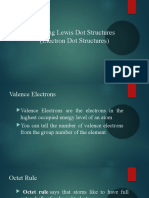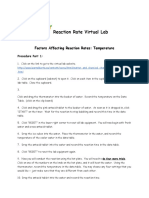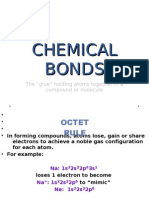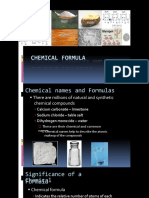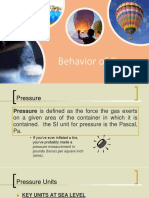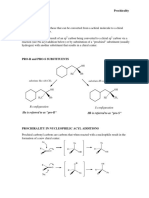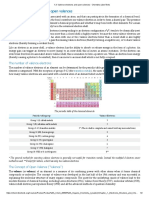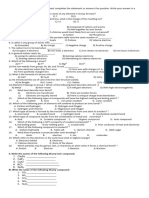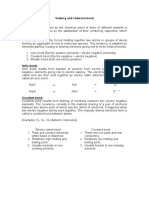Electronic Configuration
Humans by nature tend to be systematic and that is achieved by proper arrangement. Humans have tried
to arrange the elements too. Efforts were made by various chemists, and Mendeleev was one of them. He
arranged the elements by atomic weight.
Electronic configuration is the arrangement of electrons in an atom in different shells and sub-shells.
After the discovery of the shells and sub-shells, various physical and chemical properties of the elements
were linked to the electronic configuration. As a result, attempts were made to arrange elements by
their electronic configuration, so that their properties would obviously fall in a trend. Subsequently, the
modern arrangement is evolved wherein elements are organized by atomic number. This is known as
the modern periodic table.
The modern periodic table has elements arranged according to their electronic configurations. From left to
right, i.e., in a period, the arrangement is such that each subsequent electron is added to the same
shell. There are certain steps for writing the electronic configuration.
Step-1
Find out the atomic number of the element from periodic table. Since, in an atom, the number of protons
which is the atomic number is equal to the number of electrons, the atomic number will give you the
information about the number of electrons in that atom . Let's take the example of calcium. The atomic
number of calcium is 20.
Step-2
Follow the electron configuration chart.
Now, fill electrons by following the arrows of the electron configuration chart. Remember that the s-orbital
can accommodate a maximum of two electrons while the p-orbital sets can hold six electrons in three
orbitals. In the same way d-orbital set contains ten and f-orbital sets contain fourteen electrons in five and
seven orbitals respectively.
Step-3
After filling given electrons in the energy levels, write the electronic configuration in the given manner.
[X] [Y] [Z]
�Where, X represents the energy level, Y is for the sub-shell which is named as s, p, d and f. The number
of sub-shells increases with the energy level. The number Z is the number of electrons present in a subshell.
We can represent electron configuration chart by using principle quantum number notifications also.
For filling given electrons, we have to start form the K shell and move to higher levels.
Electronic Configuration in the Period
Back to Top
Example
Configuration of Li atomic number. 3, is 1s2 , 2s1
Configuration of Be atomic no. 4, is 1s2 , 2s2
Configuration of B atomic no. 5, is 1s2 , 2s2, 2p1
Configuration of C atomic no. 6, is 1s2 , 2s2 , 2p2
and so on till Neon,the last element.
This addition of each subsequent electron results in a completely new configuration and as a result the
chemical properties of the subsequent element changes gradually. At the end of each row, a drastic shift
occurs in the chemical properties.
�Use the below widget to find the electron configuration.
Electronic Configuration in the Group
Back to Top
From top to bottom in a column, i.e., in a group, each subsequent electron is added to the new shell, but
in the same sub-shell, e.g., in the 1st group,
Configuration of H atomic number.1,is 1s1
Configuration of Li atomic no. 3, is 1s2 ,2s1
Configuration of Na atomic no. 11, is 1s2 ,s2,2p6 ,3s1
Configuration of K atomic no. 19, is 1s2 ,2s2 ,2p6,3s2 ,3p6,4s1
and so on till Neon, the last element.
The number of valence shell electrons in an atom would determine the way it will interact with other atoms
and therefore determines its chemical properties.
Thus the outermost configuration, which is responsible for various properties such as valency, oxidation
states, etc., remains same. Hence in a group, the physical and chemical properties are same.To illustrate,
the halogens are strong electronegative elements.
Valence Electron Configuration
Back to Top
The electrons present in the outer most shell of an atom which takes part in chemical reactions, are
known as valence electrons.
These electrons can combine with valence electrons of other atoms to form chemical bonds. Hence
valence electrons affect the chemical properties and bonding nature of an atom.
The electronic configuration of the outer most shell of an element is known as valence electron
configuration.
Its easy to write the valence electron configuration for the main group of elements (group 1,2 & 13-18),
because the electron present in the electronic shell of the highest principal quantum number are valence
electrons and their electronic representation will be easy. For example, the electronic configuration of
Cesium (Cs) is 1s2 2s2 2p6 3s2 3p6 3d10 4s2 4p6 4d10 5s2 5p6 6s1 so that there is one valence electron in 6s
and the valence electron configuration will be 6s1.
But in case of d and f block elements, the valence electron configuration involves the penultimate shell
and the ultimate shell also. Hence, the general valence electron configuration of the various blocks is
Element
Valence Electron Configuration
s-block element
ns1
p-block element
ns2 , np 1-6
d-block element
(n - 1)d 1-10,ns 1-2
f-block element
(n - 2)f 1-14(n - 1)d 0-1nsa
�Electron Configuration Table
Back to Top
We can show the electron configuration of an element in a tabular form also. Such type of tabular form is
termed as electron configuration table. This table describes the number of electrons in each energy level
of an atom as well as their arrangement. Electron configuration table is the best way to represent an
atom as it shows all the information regarding the energy levels of an atom in a small space.
For example, the electron configuration table for Thallium (Tl) with atom number 81 is given below
1s2
2s2 2p6
3s2 3p6 3d10
4s2 4p6 4d10 4f14
5s2 5p6 5d10
6s2 6p1
Electron Configuration List
Back to Top
The following table shows the electron configuration chart of the elements of the periodic table.
Atomic
Number
Name of
element
Symbol
Grou Electron
p
Configuration
Hydrogen
1s1
Helium
He
18
1s2
Symbol, group/series/block
and Comments
Group 0/18 Noble Gas,
Lithium
Li
[He] 2s
s-block, Group 1 Alkali Metal,
Beryllium
Be
[He] 2s2
Borom
13
[He] 2s2 2p1
s-block, Group 2 Alkaline
Earth Metal,
p-block, Group 3/13
Carbon
14
[He] 2s 2p
p-block, Gp4/14,
Nitrogen
15
[He] 2s2 2p3
p-block, Gp5/15,
Oxygen
16
[He] 2s 2p
Fluorine
17
[He] 2s2 2p5
10
Neon
Ne
18
[He] 2s 2p
1
11
Sodium
Na
[Ne] 3s
12
Magnesium
Mg
[Ne] 3s2
13
Aluminium
Al
13
[Ne] 3s2 3p1
14
Silicon
Si
14
p-block, Gp6/16,
p-block, G p7/17 Halogen,
p-block, Gp 0/18 Noble Gas,
Gp1 Alkali Metal,
s-block, Gp2 Alkaline Earth
Metal,
[Ne] 3s 3p
p-block, Gp3/13,
p-block, Gp4/14,
�15
Phosphorus
15
[Ne] 3s2 3p3
p-block, Gp5/15,
16
Sulphur
16
[Ne] 3s2 3p4
p-block, Gp6/16,
17
Chlorine
Cl
17
[Ne] 3s 3p
p-block, Gp7/17 Halogen,
18
Argon
Ar
18
[Ne] 3s2 3p6
p-block, Gp 0/18 Noble Gas,
19
Potassium
[Ar] 4s
20
Calcium
Ca
[Ar] 4s2
s-block, Gp2 Alkaline Earth
Metal,
21
Scandium
Sc
[Ar] 3d1 4s2
3d block, not true Transition
Metal
22
Titanium
Ti
[Ar] 3d2 4s2
3d block, a true Transition
Metal
23
Vanadium
[Ar] 3d3 4s2
3d block, a true Transition
Metal
24
Chromium
Cr
[Ar] 3d5 4s1
3d block, a true Transition
Metal
25
Manganese
Mn
[Ar] 3d5 4s2
3d block, a true Transition
Metal
26
Iron
Fe
[Ar] 3d6 4s2
3d block, a true Transition
Metal
27
Cobalt
Co
[Ar] 3d7 4s2
3d block, a true Transition
Metal
28
Nickel
Ni
10
[Ar] 3d8 4s2
3d block, a true Transition
Metal
29
Copper
Cu
11
[Ar] 3d10 4s1
3d block, a true Transition
Metal
30
Zinc
Zn
12
[Ar] 3d10 4s2
3d block, not true Transition
Metal
31
Gallium
Ga
13
[Ar] 3d10 4s2 4p1
p-block, Gp3/13,
32
Germanium
Ge
14
[Ar] 3d10 4s2 4p2
p-block, Gp4/14,
15
10
[Ar] 3d 4s 4p
p-block, Gp5/15,
10
33
Arsenic
As
s-block, Gp1 Alkali Metal,
34
Selenium
Se
16
[Ar] 3d 4s 4p
p-block, Gp6/16,
35
Bromine
Br
17
[Ar] 3d10 4s2 4p5
p-block, Gp7/17 Halogen,
10
36
Krypton
Kr
18
[Ar] 3d 4s 4p
p-block, Gp 0/18 Noble Gas,
37
Rubidium
Rb
[Kr] 5s1
s-block, Gp1 Alkali Metal,
38
Strontium
Sr
[Kr] 5s2
s-block, Gp2 Alkaline Earth
Metal,
39
Yttrium
[Kr] 4d1 5s2
4d block, not true Transition
Metal
�40
Zirconium
Zr
[Kr] 4d2 5s2
4d block, a true Transition
Metal
41
Niobium
Nb
[Kr] 4d4 5s1
4d block, a true Transition
Metal
42
Molybdenum
Mo
[Kr] 4d5 5s1
4d block, a true Transition
Metal
43
Technetium
Tc
[Kr] 4d5 5s2
4d block, a true Transition
Metal
44
Ruthenium
Ru
[Kr] 4d7 5s1
4d block, a true Transition
Metal
45
Rhodium
Rh
[Kr] 4d8 5s1
4d block, a true Transition
Metal
46
Palladium
Pd
10
[Kr] 4d10
4d block, a true Transition
Metal
47
Silver
Ag
11
[Kr] 4d10 5s1
4d block, a true Transition
Metal
48
Cadmium
Cd
12
[Kr] 4d10 5s2
4d block, a true Transition
Metal
49
Indium
In
13
[Kr] 4d10 5s2 5p1
p-block, Gp3/13,
50
Tin
Sn
14
[Kr] 4d10 5s2 5p2
p-block, Gp4/14,
15
10
[Kr] 4d 5s 5p
p-block, Gp5/14,
10
51
Antimony
Sb
52
Tellurium
Te
16
[Kr] 4d 5s 5p
p-block, Gp6/16,
53
Iodine
17
[Kr] 4d10 5s2 5p5
p-block, Gp7/17 Halogen,
10
54
Xenon
Xe
18
[Kr] 4d 5s 5p
p-block, Gp 0/18 Noble Gas,
55
Cesium
Cs
[Xe] 6s1
s-block, Gp1 Alkali Metal,
56
Barium
Ba
[Xe] 6s2
s-block, Gp2 Alkaline Earth
Metal,
57
Lanthanum
La
[Xe] 5d1 6s2
Start of 5d-bock and
Lanthanide Series
58
Cerium
Ce
101
[Xe] 4f1 5d1 6s2
1st of f-block in the
Lanthanides Metals
59
Praseodymium Pr
101
[Xe] 4f3 6s2
f-block in the Lanthanides
Metals
60
Neodymium
Nd
101
[Xe] 4f4 6s2
f-block in the Lanthanides
Metals
61
Promethium
Pm
101
[Xe] 4f5 6s2
f-block in the Lanthanides
Metals
62
Samarium
Sm
101
[Xe] 4f6 6s2
f-block in the Lanthanides
Metals
�63
Europium
Eu
101
[Xe] 4f7 6s2
f-block in the Lanthanides
Metals
64
Gadolinium
Gd
101
[Xe] 4f7 5d1 6s2
f-block in the Lanthanides
Metals
65
Terbium
Tb
101
[Xe] 4f9 6s2
f-block in the Lanthanides
Metals
66
Dysprosium
Dy
101
[Xe] 4f10 6s2
f-block in the Lanthanides
Metals
67
Holmium
Ho
101
[Xe] 4f11 6s2
f-block in the Lanthanides
Metals
68
Erbium
Er
101
[Xe] 4f12 6s2
f-block in the Lanthanides
Metals
69
Thulium
Tm
101
[Xe] 4f13 6s2
f-block in the Lanthanides
Metals
70
Ytterbium
Yb
101
[Xe] 4f14 6s2
f-block in the Lanthanides
Metals
71
Lutetium
Lu
101
[Xe] 4f14 5d1 6s2
f-block in the Lanthanides
Metals
72
Hafnium
Hf
[Xe] 4f14 5d2 6s2
d-block element
73
Tantalum
Ta
[Xe] 4f14 5d3 6s2
d-block element
14
[Xe] 4f 5d 6s
d-block element
14
d-block element
74
Tungsten
75
Rhenium
Re
[Xe] 4f 5d 6s
76
Osmium
Os
[Xe] 4f14 5d6 6s2
d-block element
14
d-block element
77
Iridium
Ir
[Xe] 4f 5d 6s
78
Platinum
Pt
10
[Xe] 4f14 5d9 6s1
d-block element
11
14
10
[Xe] 4f 5d 6s
d-block element
14
10
d-block element
79
Gold
Au
80
Mercury
Hg
12
[Xe] 4f 5d 6s
81
Thallium
TI
13
[Xe]4f14 5d10 6s2 6p1 p-block element
82
Lead
Pb
14
[Xe]4f14 5d10 6s2 6p2 p-block element
83
Bismuth
Bi
15
[Xe]4f14 5d10 6s2 6p3 p-block element
84
Polonium
Po
16
[Xe]4f14 5d10 6s2 6p4 p-block element
85
Astatine
At
17
[Xe]4f14 5d10 6s2 6p5 p-block element
86
Radon
Rn
18
[Xe]4f14 5d10 6s2 6p6 p-block element
87
Francium
Fr
[Rn] 7s1
s-block radioactive element
from 1st group
88
Radium
Ra
[Rn] 7s2
s-block radioactive element
from 2nd group
�89
Actinium
Ac
[Rn] 6d1 7s2
d-block element , 1st element of
actinide
90
Thorium
Th
102
[Rn] 6d2 7s2
f-block element , actinide
91
Protactinium
Pa
102
[Rn] 5f2 6d1 7s2
f-block element , actinide
f-block element , actinide
92
Uranium
102
[Rn] 5f 6d 7s
93
Neptunium
Np
102
[Rn] 5f4 6d1 7s2
f-block element , actinide
102
f-block element , actinide
f-block element , actinide
94
Plutonium
Pu
[Rn] 5f 7s
95
Americium
Am
102
[Rn] 5f 7s
96
Curium
Cm
102
[Rn] 5f7 6d1 7s2
f-block element , actinides
f-block element , actinides
97
Berkelium
Bk
102
[Rn] 5f 7s
98
Californium
Cf
102
[Rn] 5f107s2
11
f-block element , actinides
f-block element , actinides
99
Einsteinium
Es
102
[Rn] 5f 7s
100
Fermium
Fm
102
[Rn] 5f127s2
101
Mendelevium Md
102
f-block element , actinides
13
f-block element , actinides
14
f-block element , actinides
[Rn] 5f 7s
102
Nobelium
No
102
[Rn] 5f 7s
103
Lawrencium
Lr
102
[Rn] 5f146d17s2
14
f-block element , actinides
Artificial radioactive element
and the first transactinide
element.
104
Rutherfordium Rf
[Rn] 5f 6d 7s
105
Dubnium
Db
[Rn] 5f146d37s2
Artificial radioactive element
106
Seaborgium
Sg
[Rn] 5f146d47s2
Artificial radioactive element
that does not occur in nature
107
Bohrium
Bh
[Rn] 5f146d57s2
Radioactive element
108
Hassium
Hs
[Rn] 5f146d67s2
Radioactive element
14
Radioactive element
109
Meitnerium
Mt
[Rn]5f 6d 7s






